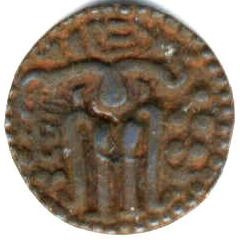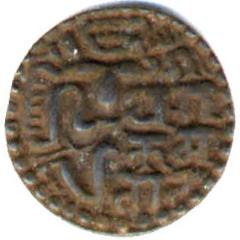| SPECIFICATIONS | |
| Denomination | massa |
| Alloy | Copper |
| Type | Struck |
| Diameter | 19.44 mm |
| Thickness | mm |
| Weight | 4.20 gms |
| Shape | Round |
| Edge | Plain |
| DieAxis | O° |


|

| 
| ||||||||||||||||||||
| Codrington #84 | Mitchiner #845-847 | |||||||||||||||||||||
|
Obverse : Traditional Lankan massa design of standing king. The head consists of an irregular oblong, the right side being a vertical line, from which projects three horizontal stokes representing the nose, mouth and chin. The crown bulging outwards at the back. The two curved lines on either side of the legs slightly turned upwards at the end indicate a person wearing a 'dhoti', and standing on a lotus stalk with flower to the right. The forearm is bent sharply down; the hand grasps the hanging lamp. The right side elbow is curved down with the arm turned upwards holds a flower presumed to be a jasmine blossom. To the right are five dots or spheres. A rim of 40 to 43 beads. Reverse : Traditional Lankan massa design of seated king. Head and crown as on obverse. Arm is raised upwards and the hand holds a conch shell. On right Nagari legend Sri Pa ra kra ma Ba hu | 
|
This is one of six fairly common copper massa coins from the late Polonnaruwa and Dambadeniya era.
I quote from Codrington's "Short history of Ceylon"
since the ancient chronicle Culavamsa becomes too verbose
in this period.
The Sinhala king Vijayabahu III (1232-1236), who had attained the
sovereignty well on in life, made his capital at Dambadeniya in
Kurunegala District, and calling back the priests from India conveyed
the Tooth and Bowl Relics from their hiding place in Kotmale to the
seat of government. He only reigned four years, and before his death
committed to the care of the priesthood his sons, ParakramaBahu and
BhuvanaikaBahu, both of whom were children. Pandita ParakramaBahu II
(1236-1271), was born at Sirivardhanapura not far from
Dambadeniya. His first act after his coronation was to bring the Tooth
Relic and lodge it at the capital. He then turned his attention to the
recovery of Polonnaruva from the Pandaya, and achieved this purpose by
1244. The rest of the reign according to the contemporary records was
spent in pious works ; the king also held a convocation for the
purpose of reforming the priesthood, whose discipline had been relaxed
during the Pandaya occupation. After reigning thirty-three years he
abdicated in favor of his eldest son VijayaBahu. Having attended to
restorations at Anuradhapura, VijayaBahu sent for his father to
Polonnaruwa, where he was crowned a second time. The Tooth Relic
having been brought, Parakrama held his ninth ordination festival at
Dahastota, and then returned to Dambadeniya, where he died in his
thirty-fifth year.
Text edited from
* Ceylon Coins and Currency: H. W. Codrington, Colombo, 1924.
Chapter VI Mediaeval Lanka - Sinhala of 12th & 13th Century - Series II, Page 70
* Culavamsa II Chapter LXXXI: Translation by Wilhelm Geiger. Pali Text Society 1930
The coin was scanned at 300dpi and displayed at 300dpi is from my original collection from Lanka.